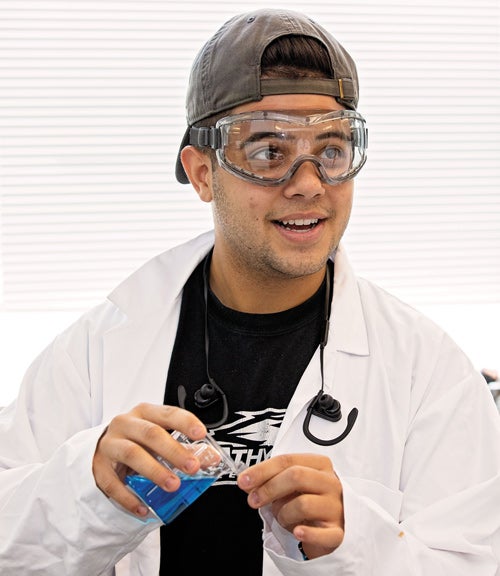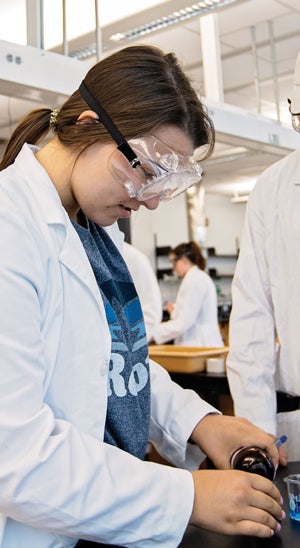X Marks The Lab
New model revolutionizes lab courses

Laith Hamed prepares a solution in an experiment to reverse engineer purple dye.
From the elevator, turn left down the hall and take 20 paces. Turn left again, and X marks the spot where Pirates are learning science in East Carolina University’s new, more effective laboratory classes. X-Labs is a cross-disciplinary project aimed at changing the way instructors introduce scientific experimentation to students in chemistry, biology and physics lab courses.
For decades, science labs have looked the same.
“You give students prescriptive, cookbook, scripted labs where they’re told, ‘Add 3 milliliters of this, add one drop of that,’ and oh look, it turned blue,” says Joi Walker, assistant professor of chemistry. “Believe it or not, those are not
in any way valuable in terms of education.”
In the redesigned labs, based on the Argument-Driven Inquiry model, experiments are based on a guiding question. In small groups, the students design and conduct an experiment to answer the question, present and defend their results to other groups, and write a lab report. Walker says the process better prepares students for actual scientific research and makes more efficient use of valuable class time.
“The laboratory is an integral part of science education,” she says. “It’s a three-hour block of time, we have amazing facilities, you have an inherently small student-to-teacher ratio, and so some of what I’m trying to do is use that time to do things that we can’t do in class. Like writing. Like presentations,” she says.
Rather than focusing on following a prescribed set of steps to get the right result, the emphasis is on learning how to use experimentation to answer a question, as well as developing the ability to explain and justify the results. The inherent messiness of having students design their own experiments is part of the beauty of the ADI model, Walker says.
“It gives them an opportunity to see, ‘Oh, we got different results. We got a different outcome. Our answer may not be exactly the same as someone else’s.’ And that’s science,” she says. “I would rather a student be able to justify and explain what went wrong. That’s when you really understand it.”
One of the challenges of developing the curriculum for the labs, she says, has been coming up with questions that are answerable, but not easily answerable, because if all the students get the same answer, there’s little room for discussion and argumentation.
Pirate Purple
In a chemistry lab on measuring the concentration of chemicals in a solution, students are given a scenario in which they need to produce Pirate purple dye for a sports drink. By analyzing samples, they reverse engineer the dye to calculate its contents and determine how they would make more.
“I didn’t tell them how to set it up,” says Eli Hvastkovs, associate professor of analytical chemistry. “They have to set up the lab themselves – lay out a plan and write a proposal. The idea is for them to explore on their own, collect data and come up with an argument that answers a question.”
Chemistry major Victoria Preston says the process was more engaging compared to non-ADI labs. Working in groups helped her see different perspectives and allowed an opportunity to bounce ideas off of each other, she says. The peer review of lab reports also helped.
“It was a great way to understand the material better,” she says. “Some people understood certain parts of the experiment better than others, so reading over everyone’s papers helped piece together parts that I was less confident on.”
Preston, who plans to attend medical school, says the two ADI labs she’s taken helped her build confidence in her research skills and learn how to work as part of a team while still thinking independently.
Setting up labs with a consistent format across disciplines means students know what to expect from lab courses once they’ve had one, whether it’s in chemistry, biology or physics.
Students aren’t the only ones with positive feedback on the ADI model. Walker says a faculty member with 17 years of experience told her the first time he taught an ADI lab was the first time he felt like he taught real science.

Redesigned labs in chemistry, biology and physics are using the Argument-Driven Inquiry model. Here, Sophia Villani works to determine the composition of a solution.
Driven by Results
The X-Labs team, which includes principal investigators Walker, Kris Callis-Duehl, assistant professor of biology, and Steven Wolf, assistant professor of physics, is tracking the impact of the new lab model on student success and retention as part of a three-year, $598,000 grant from the National Science Foundation. The study already includes more than 1,200 students.
“Science identity is key to retention of STEM majors,” Walker says. “Even a student who’s a C student, if they identify and feel like they can do science, they will stay in science. We were pretty excited to see that after just one semester, we saw a shift in identity, a positive shift in science identity.”
Results also show improvement in the students’ ability to engage in argumentation and in writing ability. Walker says the study will provide statistical analysis that will not only show the overall benefit of the program but also breakdowns of which students benefit the most and how different groups of students benefit from the improved lab model.
The project includes sharing the curriculum with community colleges in the region; Lenoir Community College is implementing the chemistry curriculum next year, and the team is working to bring Pitt Community College and Beaufort Community College on board as well.
